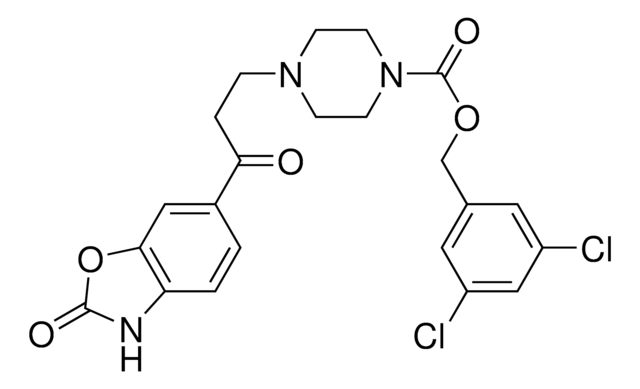H8384
(Hydroxypropyl)methyl cellulose
viscosity 40-60 cP, 2 % in H2O(20 °C)(lit.)
Sinônimo(s):
2-Hydroxypropyl methyl cellulose ether
About This Item
Produtos recomendados
forma
powder
peso molecular
~22 kDa
cor
beige
viscosidade
40-60 cP, 2 % in H2O(20 °C)(lit.)
solubilidade
water: 10 mg/mL, clear to slightly hazy
temperatura de armazenamento
room temp
Procurando produtos similares? Visita Guia de comparação de produtos
Aplicação
Características e benefícios
Qualidade
Nota de preparo
Dispersion in hot water:
1. Heat approximately 1/3 the required volume of water to at least 90 oC.
2. Add the powder to the heated water with stirring or agitation.
3. Agitate the mixture until the particles are thoroughly wetted and evenly dispersed.
4. Add the remainder of the water (cold water) to lower the temperature of the dispersion. As the product cools, it will reach a temperature at which it becomes water soluble. It will then begin to hydrate and dissolve, increasing the viscosity of the solution.
5. Continue agitation for at least 30 minutes after the proper temperature is reached for solubility. The solution is now ready to use.
Dry blending:
1. Combine powder with other dry ingredients. The suggested ratio of dry powder to hydroxypropylmethylcellulose is 7:1 to 3:1.
2. Thoroughly blend the dry ingredients.
3. Add the dry mixture to water with agitation.
4. Agitate until the product has completed hydrated and the solution is consistently smooth. The solution is now ready for further processing/use.
Dispersion in non-solvent medium:
1. Hydroxypropylmethylcellulose may be dispersed in non-solvent media such as vegetable oil, polyethylene glycol, glycerin, corn syrup, and concentrated salt solutions. A ratio of 5-8 parts non-solvent to 1 part hydroxypropylmethylcellulose is recommended to obtain a liquid slurry.
2. Agitate the mixture until the particles are evenly dispersed.
3. This dispersion may be added to cold water or cold water may be added to the dispersion.
4. Continue mixing until the powder is completely hydrated and the solution is smooth. Additional ingredients may now be added to the formulation.
Outras notas
Código de classe de armazenamento
11 - Combustible Solids
Classe de risco de água (WGK)
WGK 1
Ponto de fulgor (°F)
Not applicable
Ponto de fulgor (°C)
Not applicable
Equipamento de proteção individual
Eyeshields, Gloves, type N95 (US)
Certificados de análise (COA)
Busque Certificados de análise (COA) digitando o Número do Lote do produto. Os números de lote e remessa podem ser encontrados no rótulo de um produto após a palavra “Lot” ou “Batch”.
Já possui este produto?
Encontre a documentação dos produtos que você adquiriu recentemente na biblioteca de documentos.
Os clientes também visualizaram
Nossa equipe de cientistas tem experiência em todas as áreas de pesquisa, incluindo Life Sciences, ciência de materiais, síntese química, cromatografia, química analítica e muitas outras.
Entre em contato com a assistência técnica


